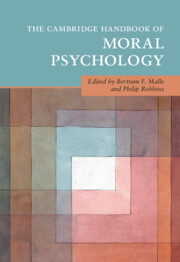Book contents
- The Cambridge Handbook of Moral Psychology
- Cambridge Handbooks in Psychology
- The Cambridge Handbook of Moral Psychology
- Copyright page
- Contents
- Figures
- Tables
- Contributors
- Preface
- 1 Modern Moral Psychology
- Part I Building Blocks
- Part II Thinking and Feeling
- 7 Moral Decision Making
- 8 Are Moral Judgments Rational?
- 9 Moral Categorization and Mind Perception
- 10 Moral Emotions
- 11 The Benefits and Costs of Empathy in Moral Decision Making
- Part III Behavior
- Part IV Origins, Development, and Variation
- Part V Applications and Extensions
- Index
- References
7 - Moral Decision Making
The Value of Actions
from Part II - Thinking and Feeling
Published online by Cambridge University Press: 20 February 2025
- The Cambridge Handbook of Moral Psychology
- Cambridge Handbooks in Psychology
- The Cambridge Handbook of Moral Psychology
- Copyright page
- Contents
- Figures
- Tables
- Contributors
- Preface
- 1 Modern Moral Psychology
- Part I Building Blocks
- Part II Thinking and Feeling
- 7 Moral Decision Making
- 8 Are Moral Judgments Rational?
- 9 Moral Categorization and Mind Perception
- 10 Moral Emotions
- 11 The Benefits and Costs of Empathy in Moral Decision Making
- Part III Behavior
- Part IV Origins, Development, and Variation
- Part V Applications and Extensions
- Index
- References
Summary
This chapter of the handbook introduces some core elements of moral decision making by framing it from one particular perspective: expected utility theory. In its classic form, expected utility theory focuses on the outcomes of actions: the expected utility of a decision is the sum of the values associated with the different possible outcomes of the decision weighted by the probability of their occurrence. As such, expected utility theory is well suited to explain the moral choices recommended by utilitarianism, which characterizes right actions in terms of the maximization of aggregate utility. As the authors point out, however, expected utility theory can be also used to model nonutilitarian decision making by assigning utilities to actions themselves, not just their outcomes. This action-based form of expected utility theory can readily accommodate the fact that people tend to assign low utility to actions that violate moral norms. Further, action-based expected utility theory can explain a wide range of phenomena revealed by empirical research on moral decision making, such as interpersonal disagreement about fairness, in-group bias, and outcome neglect.
- Type
- Chapter
- Information
- The Cambridge Handbook of Moral Psychology , pp. 153 - 171Publisher: Cambridge University PressPrint publication year: 2025

